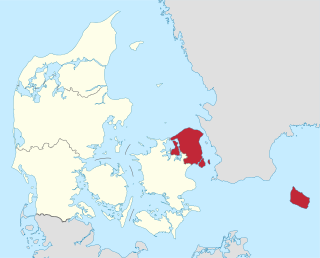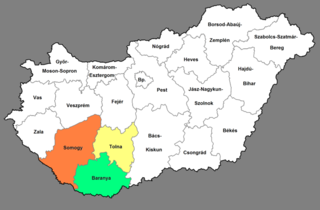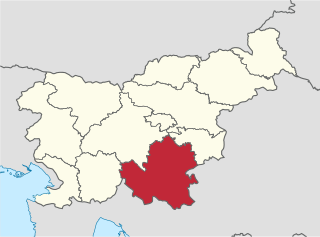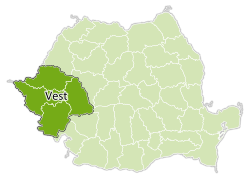
The regional policy of the European Union (EU), also referred as Cohesion Policy, is a policy with the stated aim of improving the economic well-being of regions in the European Union and also to avoid regional disparities. More than one third of the EU's budget is devoted to this policy, which aims to remove economic, social and territorial disparities across the EU, restructure declining industrial areas and diversify rural areas which have declining agriculture. In doing so, EU regional policy is geared towards making regions more competitive, fostering economic growth and creating new jobs. The policy also has a role to play in wider challenges for the future, including climate change, energy supply and globalisation.

The development regions of Romania refer to the eight regional divisions created in Romania in 1998 in order to better co-ordinate regional development as Romania progressed towards accession to the European Union (EU). The development regions correspond to NUTS 2-level divisions in EU member states. Despite becoming increasingly significant in regional development projects, Romania's development regions do not actually have an administrative status and do not have a legislative or executive council or government. Rather, they serve a function for allocating EU PHARE funds for regional development, as well as for collection of regional statistics. They also co-ordinate a range of regional development projects and became members of the Committee of the Regions when Romania joined the EU on January 1, 2007.

Nord-Vest is a development region in Romania, created in 1998. As other development regions, it does not have any administrative powers, its main function being to co-ordinate regional development projects and manage funds from the European Union.

Nord-Est is a development region in Romania. As other development regions, it does not have any administrative powers, its main function being to co-ordinate regional development projects and manage funds from the European Union.

Sud-Est is a development region in Romania. As with other development regions, it does not have any administrative powers, its main function being to co-ordinate regional development projects and manage funds from the European Union.

Centru (Centre) is a development region in Romania. As other development regions, it does not have any administrative powers, its main function being to co-ordinate regional development projects and manage funds from the European Union.

The Capital Region of Denmark is the easternmost administrative region of Denmark, and contains Copenhagen, the national capital.

The North Jutland Region, or in some official sources, the North Denmark Region, is an administrative region of Denmark established on 1 January 2007 as part of the 2007 Danish municipal reform, which abolished the traditional counties and set up five larger regions. At the same time, smaller municipalities were merged into larger units, cutting the number of municipalities from 271 before 1 January 2006, when Ærø Municipality was created, to 98. North Jutland Region has 11 municipalities. The reform diminished the power of the regional level dramatically in favor of the local level and the central government in Copenhagen.

Central Transdanubia is a statistical region of Hungary. The capital is Székesfehérvár. It is part of Transdanubia region. Central Transdanubia includes counties of Fejér, Komárom-Esztergom, and Veszprém.

Western Transdanubia is a statistical region of Hungary. It is part of the Transdanubia region. Western Transdanubia includes the counties of Zala, Vas, and Győr-Moson-Sopron.

Southern Transdanubia is a statistical region of Hungary. It is part of the Transdanubia region. Southern Transdanubia includes the counties of Somogy, Tolna, and Baranya. Its capital and largest city is Pécs. It borders Croatia to the south, the Southern Great Plain NUTS 2 region to the east, the Central Transdanubia NUTS 2 region to the north, and the Western Transdanubia NUTS 2 region to the north-west.

The Northern Great Plain is a statistical region of Hungary. It is part of the Great Plain and North region. The Northern Great Plain includes the counties of Hajdú-Bihar, Jász-Nagykun-Szolnok, and Szabolcs-Szatmár-Bereg, with a total area of 17,749 km2 (6,853 sq mi) and a population of around 1.5 million. The region is in the eastern part of Hungary. It borders northern Hungary to the north, Ukraine to the north-east, Romania to the south-east, the Southern Great Plain region of Hungary to the south, and central Hungary to the west. The region's centre, and capital city is Debrecen, the second largest city within Hungary.

The Southern Great Plain is a statistical region of Hungary. It is part of Great Plain and North region. The Southern Great Plain includes the counties of Bács-Kiskun, Békés, and Csongrád-Csanád. The region is in the southern part of Hungary. It borders Central Hungary and the Northern Great Plain regions to the north, Romania to the east, Serbia to the south, and the Southern Transdanubia and Central Transdanubia regions to the west. The regional centre, and capital city is Szeged, the third largest city of Hungary.

Sud - Muntenia is a development region in Romania. As other development regions, it does not have any administrative powers, its main function being to co-ordinate regional development projects and manage funds from the European Union. It is located entirely in the historic region of Muntenia, with its Development Agency HQ in Călărași.

Severozapaden, is a region of Bulgaria. The capital is the city of Pleven. The region has the lowest-ranked economy in Bulgaria and the European Union, with a GDP per capita (PPS) of €9,300 or 31% of EU28 average (2017). It includes five administrative divisions or oblasts: Vidin Province, Vratsa Province, Montana Province, Lovech Province and Pleven Province.

Yuzhen Tsentralen Planning Region is a Bulgarian planning region. The capital is Plovdiv, the second-largest city in Bulgaria. It includes five Bulgarians provinces: Plovdiv Province, Pazardzhik Province, Smolyan Province, Kardzhali Province and Haskovo Province.

Sud-Vest Oltenia is a development region in Romania. As the other development regions, it does not have any administrative powers, its main function being to co-ordinate regional development projects and manage funds from the European Union.

The Southeast Slovenia Statistical Region is a statistical region in southeast Slovenia. It is the largest statistical region. The development of this region is largely the result of industry, which generated nearly half of the gross value added in the region in 2012. According to the latest available data for 2013, 94% of waste water in the region was treated before it was discharged from the public sewage system. This is significantly more than in Slovenia as a whole (78%). The expenditure on research and development (R&D), which amounted to 5.2% of the regional GDP in 2012, highlights the importance of R&D in the region. Businesses accounted for 90% of the sources of financing. The population's age structure in this region is favourable. In mid-2013 the value of the ageing index was 105.2, which means that the ratio between the population 65 or older and the population 15 or less was 105 older people per 100 young people.

The București – Ilfov development region is a development region in Romania, encompassing the national capital, Bucharest, as well as the surrounding Ilfov County. As other development regions, it does not have any administrative powers, its main function being to co-ordinate regional development projects and manage funds from the European Union. It is also used as an entity in regional statistical analysis at the European Union NUTS-II level.

Zemgale Planning Region is a planning region of Latvia located within the south-center of the country. Established in 2002, the planning region contains 22 municipalities: 20 local governments and two major cities, the largest being Jelgava. As of 2020, the region's population was 228,409.





















